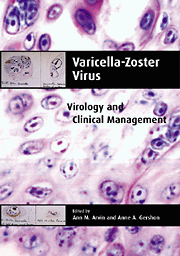Book contents
- Frontmatter
- Contents
- List of contributors
- Preface
- Introduction
- Part I History
- Part II Molecular Biology and Pathogenesis
- Part III Epidemiology and Clinical Manifestations
- 10 Epidemiology of varicella
- 11 Clinical manifestations of varicella
- 12 Epidemiology of herpes zoster
- 13 Clinical manifestations of herpes zoster
- 14 Ophthalmic zoster
- 15 Postherpetic neuralgia and other neurologic complications
- 16 Varicella and herpes zoster in pregnancy and the newborn
- Part IV Laboratory Diagnosis
- Part V Treatment and Prevention
- Index
- Plate section
16 - Varicella and herpes zoster in pregnancy and the newborn
from Part III - Epidemiology and Clinical Manifestations
Published online by Cambridge University Press: 02 March 2010
- Frontmatter
- Contents
- List of contributors
- Preface
- Introduction
- Part I History
- Part II Molecular Biology and Pathogenesis
- Part III Epidemiology and Clinical Manifestations
- 10 Epidemiology of varicella
- 11 Clinical manifestations of varicella
- 12 Epidemiology of herpes zoster
- 13 Clinical manifestations of herpes zoster
- 14 Ophthalmic zoster
- 15 Postherpetic neuralgia and other neurologic complications
- 16 Varicella and herpes zoster in pregnancy and the newborn
- Part IV Laboratory Diagnosis
- Part V Treatment and Prevention
- Index
- Plate section
Summary
Introduction
When primary or recurrent infection with VZV occurs during pregnancy, the consequences for both the mother and the fetus must be considered. Chickenpox in pregnancy may be associated with severe maternal disease, fetal death and rarely, during the first two trimesters, with congenital varicella syndrome (CVS). Maternal varicella around term carries the risk of serious neonatal disease. Various congenital defects have been reported after maternal zoster in pregnancy, but evidence for a causal association with maternal infection is lacking. This chapter reviews the outcome and management of maternal chickenpox and zoster, and the associated risks to the fetus.
Varicella
Epidemiology of infection in pregnancy
The incidence of varicella in pregnancy is determined by the proportion of women of childbearing age who are susceptible to infection and their opportunity for exposure to VZV during pregnancy. Serological surveys in temperate climates have shown that fewer than 10% of the adult population is susceptible (Ndumbe et al., 1985). In Germany, the seroprevalence to varicella was studied annually from 1984 to 1997 in more than 26000 pregnant women aged 20–40 years; the seronegative rate was about 5.6%, with no significant change over the period (Enders, 1985; Enders et al., 1994) (Enders, 1998, unpublished). In the US, a recent survey found that the proportion of susceptible adults aged 20–29 years was 5%, dropping to 1.1% in those aged 30–39 years (Chapter 10). However, the proportion susceptible is greater in some populations, for example, black Americans born in the US and individuals born in tropical countries (Gershon et al., 1976; Ooi et al., 1992; Garnett et al., 1993; Dworkin, 1996).
- Type
- Chapter
- Information
- Varicella-Zoster VirusVirology and Clinical Management, pp. 317 - 348Publisher: Cambridge University PressPrint publication year: 2000
- 35
- Cited by



